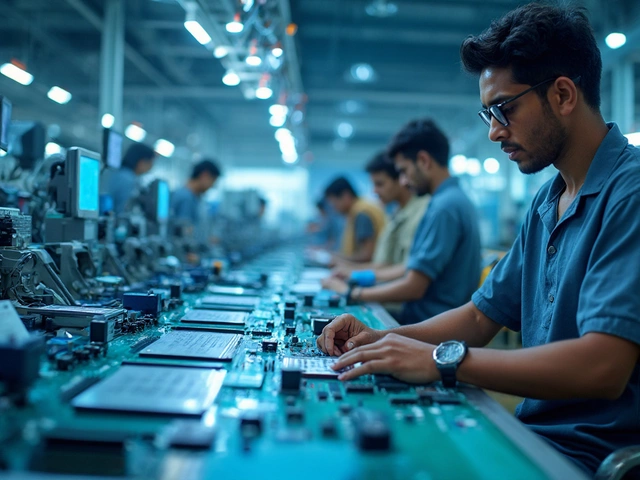Picture this: Over a billion mobile phones buzzing in pockets, laptops flashing in cafés from Mumbai to Manipur, smart TVs streaming cricket matches into Indian homes. But open one up and take a good look—none of the core chips beating at the heart of those gadgets got made in India, even in 2025. With so much tech demand, why isn’t “Made in India” stamped on a single leading-edge semiconductor chip? The answer isn’t just about money. It’s a tangle of missed chances, global dependencies, and a dash of geopolitical drama. Let’s rip open the circuit board and see why India’s still catching up in this silicon race.
The Brutal Science of Building Chips: Infrastructure, Investment, and Everything in Between
You may have heard people call semiconductors the “oil” of the 21st century—without them, nothing runs. But fabricating a chip isn’t as simple as putting together car parts. Top foundries like TSMC in Taiwan or Samsung in South Korea work at atomic levels. Their factories—known as fabs—are so spotless and tightly controlled that a single speck of dust could cost millions.
Here’s the kicker: Setting up a state-of-the-art fab requires $10-20 billion. That’s more than the GDP of several small countries. It’s not just the machines but also the chemical supply chains, pure water (really, a chip fab needs millions of liters of ultra-pure water every day), and stable, high-quality electricity. Cities like Bangalore, Noida, and Hyderabad are India’s IT hubs. Yet, none of them offer the level of pollution control, power reliability, or high-volume logistics you see around Silicon Valley or Hsinchu Science Park in Taiwan. One Chennai-based electronics engineer told me, “We just fix voltage stabilizers at home and forget about it. But if the power dips for half a second in a fab, your silicon batch is ruined.”
Sure, India talks big about tech. But most investment energy has gone into IT services and startup apps, not into the risky, capital-swallowing business of chip making. Private firms are jittery—imagine being asked to park billions based on government promises. What if the next government changes its mind and subsidies vanish? For years, politicians promised a “chip fab coming soon.” But until 2022, not even groundwork had begun.
The Indian government’s 2022 $10-billion incentive plan finally lit a fire. But the world’s major chip players—TSMC, Intel, GlobalFoundries—didn’t bite. Most found the incentives too little or the local conditions too risky. Instead, a few homegrown firms and some international joint ventures (like ISMC, a partnership involving Next Orbit and Tower Semiconductor) signed non-binding deals. Yet, three years later, construction either hasn’t started or is mired in delays. Meanwhile, recent headlines from Gujarat and Karnataka mention government land being allotted, but not a single wafer has rolled off an Indian line in 2025.
Another overlooked detail—semiconductors are a global relay race. Making a chip requires gear and chemicals routed through the Netherlands, Japan, and the U.S. Lithography machines from ASML, photoresist supplies from Japan, and design software from California. So even if India builds factories, it still needs friends willing to sell it the secret sauce. Trade wars—like the US crackdown on China’s chip buying—show just how risky supply chains can get.
Now, the world is in the middle of a chip shortage thanks to COVID aftershocks, Russia-Ukraine turbulence, and persistent demand from AI and electric vehicles. Countries are scrambling to secure their own supplies. Yet, the truth is you can’t just “make chips” without decades of building up an ecosystem. India, even with cash in pocket and government willpower, is sprinting to catch up in a race other countries started forty years ago.
Why Making Chips Is More Than Owning Fancy Machines: Talent Gaps and Forgotten Details
So let’s say you pull together your billions and set up a shiny new chip foundry outside of Pune. Next question: Who will run it? “It’s not like coding an app or setting up an IT park,” says Priya, an engineering manager I met last week (she used to work in Singapore’s chip sector). Chip production needs highly trained engineers who know how to run and troubleshoot fab machinery. Even bigger problem: Experience. Chipmaking is one of those crafts where the tiniest mistake—a wrong chemical mix, a badly handled mask, a malfunctioning valve—trashes entire months of work.
India produces loads of engineers—seriously, over a million kids graduate every year from engineering colleges. But the chip sector—microelectronics, materials science, and lithography—is a tiny niche. According to the Indian Electronics and Semiconductor Association, the country faces a shortage of at least 30,000 skilled professionals in chip fabrication alone. Most people get trained on the job abroad, in Taiwan or the US, and few return. It’s just way easier for a young talent to join TCS, Infosys, or flip burgers at a startup than to brave the uncertainties of the Indian hardware world.
You don’t build a chip industry with lone geniuses; you need a whole ecosystem. In Taiwan, for example, you’ll find hundreds of component suppliers, packaging labs, and specialty chemicals vendors within driving distance of a fab. In India, the supply chain is scattered. One group in Noida might handle packaging (encasing chips in plastic), another in Chennai does testing, but true fabrication? Still on the wish list.
Want some relatable proof? Check online job listings—chip fabrication jobs in India are so rare that only a handful exist, and most come with “relocation required” (usually to Singapore, Malaysia, or Europe). On top of that, Indian investors too often chase quick wins—app development, fintech, SaaS—which need less up-front money and start making money sooner. The chip biz? Expect a decade of red ink before earning your first rupee.
Education also plays keep-away. Chipmaking needs not just electrical engineers, but chemists, physicists, and people good with precision machinery. But most Indian engineering colleges push outdated syllabuses—often decades behind global standards. A friend of mine finished an MTech in microelectronics, but never once laid hands on real fabrication gear. If you want hands-on work, you hop on a plane to Dresden, Austin, or Hsinchu.
There are signs of hope, though. In the last couple of years, Indian Institutes of Technology (IITs) and a couple of top-tier private colleges have opened microelectronics labs and partnerships with global players. Some of Moss’s favorite walks now go by a new campus of a technical university collaborating on chip research near our city. But turning students into fab-ready workers takes more than a few years and slick labs. It takes industry coordination, years of failure, and a messy grind nobody wants on LinkedIn.
Geopolitics, Dependency, and The Long Game: When Will Indian-Made Chips Finally Arrive?
Let’s talk about the elephant in the room: Chip manufacturing is no longer just business—it’s war by other means. During COVID, car makers worldwide had to halt production not because of lack of steel but because some $10 microchips from Taiwan or China were out of stock. America and China are both battling over chip supply chains, throwing billions and regulatory roadblocks at each other. Europe and Japan are busy on their own “chip sovereignty” missions. Where does this leave India?
India officially imports nearly all its semiconductors. The import bill crossed $18 billion last year, with chips coming mainly from China, Taiwan, South Korea, and Singapore. There’s a risk in being so exposed. With Taiwan becoming the hottest flashpoint in US-China tensions, ocean shipping lanes can snap any day, and the price of every “smart” device in India could skyrocket overnight.
This is why the Indian government rolled out those ten-billion-dollar incentives, trying to lure big players. The government also restricted investment from companies with Chinese ties, hoping to protect tech security. The next step—getting Western or Japanese partners to actually sink money and tech into India—proves trickier. Political risk, tricky regulations, and that sense of “unproven groundwork” still scare many would-be investors.
Meanwhile, India actually has one ace up its sleeve—design. Indian engineers design chips for almost every kind of device, whether for Qualcomm, AMD, or Apple. Indian chip designers are world-class, just not many are working for Indian companies. Making the leap from designing chips for others to actually fabricating them is like going from writing song lyrics to building entire concert halls.
Long story short, everyone’s making moves, but progress is measured in months and years, not days. In 2025, India is still a junior player. It’s started work on packaging, assembly, and some specialized “compound semiconductors” used for solar and power electronics. But if you want the action at the bleeding edge (3-nanometer chips for the latest iPhone or AI accelerator), you’re still waiting. Maybe your next phone’s chip will finally sport a “Made in India'' sticker, but for now, the odds are low.
So, why can’t India make semiconductor chips? It’s not one simple answer; it’s an avalanche of challenges—money, talent, logistics, and power politics. Building chips isn’t sexy, quick, or predictable. But every world-class chip hub—Taiwan, South Korea, the US—started somewhere. With the right fixes, enough grit, and a few hard lessons, India might catch up yet. Until then, the heart of your tech will keep beating with someone else’s silicon.






Write a comment